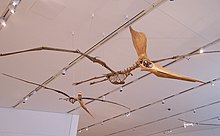Pterosaurs

Pterosaurs (meaning "winged lizard") were flying reptiles of the clade or order Pterosauria. They existed from the late Triassic to the end of the Cretaceous Period (228 to 66 million years ago. Pterosaurs are the earliest vertebrates known to have evolved powered flight. Their wings were formed by a membrane of skin, muscle, and other tissues stretching from the ankles to a dramatically lengthened fourth finger. Early species had long, fully toothed jaws and long tails, while later forms had a highly reduced tail, and some lacked teeth. Many sported furry coats made up of hair-like filaments known as pycnofibers, which covered their bodies and parts of their wings. Pterosaurs spanned a wide range of adult sizes, from the very small Nemicolopterus to the largest known flying creatures of all time, including Quetzalcoatlus and Hatzegopteryx.
Quotes
[edit]- Most people think of pterosaurs as "flying dinosaurs". When I was a boy, I remember the other kids called them "dinosaur-birds", but they were neither dinosaurs or birds. The first problem is that most people don't know any more about the fossil record than what they've seen in a few plastic pieces in a prehistoric playset. Not only do they typically think that all these things are dinosaurs, they might even think that these are all the fossil forms that are known. They have no idea how rich the fossil record is.
- Aron Ra, "Pterosaurs are Terrible Lizards", Youtube (December 3, 2013)
- Let's just ruin all the movies about pterosaurs: they could soar like airplanes, but they couldn't hover like hummingbirds. They couldn't carry things in their feet either, they couldn't perch on tree branches like birds, they didn't look like "bird-monsters", and they didn't look like "lizard-bats". They didn't have four-fingered wings like bats; their wings were based on an elongated pinky finger. The only thing bat-like about them was the way they walked; on all fours. So what are the possibilities for fluffy pterosaurs? We know they were a very diverse and almost certainly colorful group. They looked like a wide range of things, from fluttering bats to darting falcons. Some had powerful shell-crushing jaws and some had ridiculous crests, and some were quite huge. For decades, we were told that Pteranodon was the biggest animal that ever flew, then they discovered Ornithocheirus, then Quetzalcoatlus, then Hatzegopteryx (an apex predator)... These were capable killers of even human-sized prey, with a skull larger than that of even the biggest carnosaurs.
- Aron Ra, "Pterosaurs are Terrible Lizards", Youtube (December 3, 2013)
- In their evolution, we see that the earliest pterosaurs were small, and yet still unecessarily heavy and clumsy, both in the air and on the ground, but 160 million years of refinement has honed their abilities to the limit of incidental engineering. Despite their enormity, they were unbelievably lightweight; even the biggest ones were estimated at less than 500 lbs. They had hollow pneumatic bones of large diameter but only millimeters thick, making a strut-supported tubular frame that's surprisingly strong and highly resistant to the stresses of aeronautics. They also had extraordinarily powerful wing muscles, and this made them capable of vaulting airborne in a single bolt. Once in the air, muscle strands and tendons in the membrane of the wing itself worked with a network of pycnofibres to give them all the data they needed for subtle adjustments to the shape of the wing. The portions of the brain which were dedicated to flight, balance and visual gaze stabilization in birds are all larger and more adapted in pterosaurs. In fact, scientists are now convinced that these animals had such a mastery of flight, that the larger ones could even cross oceans, going 80 mph at 15,000 feet for thousands of miles on a single launch.
- Aron Ra, "Pterosaurs are Terrible Lizards", Youtube (December 3, 2013)


